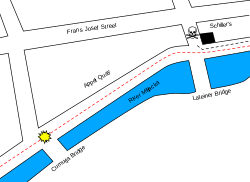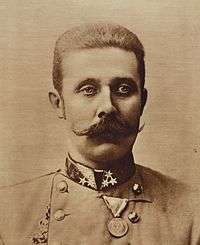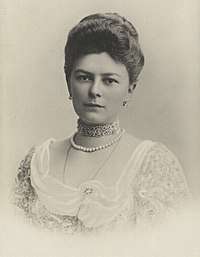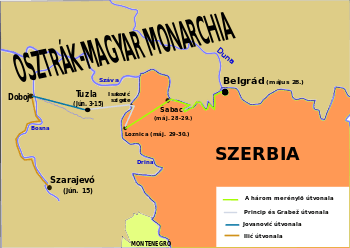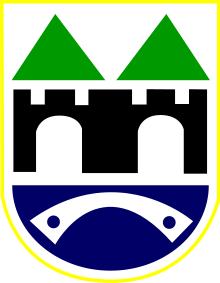Assassination of Archduke Franz Ferdinand
The assassination of Archduke Franz Ferdinand of Austria, heir presumptive to the Austro-Hungarian throne, and Franz Ferdinand's wife Sophie, Duchess of Hohenberg, occurred on 28 June 1914 in Sarajevo when they were mortally wounded by Gavrilo Princip. Princip was one of a group of six assassins also containing Muhamed Mehmedbašić, Vaso Čubrilović, Nedeljko Čabrinović, Cvjetko Popović and Trifun Grabež (one Bosniak and five Serbs consecutively) coordinated by Danilo Ilić, a Bosnian Serb and a member of the Black Hand secret society. The political objective of the assassination was to break off Austria-Hungary's South Slav provinces so they could be combined into a Yugoslavia. The conspirators' motives were consistent with the movement that later became known as Young Bosnia. The assassination led directly to World War I when Austria-Hungary subsequently issued an ultimatum to the Kingdom of Serbia, which was partially rejected. Austria-Hungary then declared war on Serbia, triggering actions leading to war between most European states.
 Assassination illustrated in the Italian newspaper Domenica del Corriere, 12 July 1914 by Achille Beltrame | |||||||
| Date | 28 June 1914 | ||||||
|---|---|---|---|---|---|---|---|
| Location | Near the Latin Bridge, Sarajevo | ||||||
| Coordinates | 43.857917°N 18.42875°E | ||||||
| Deaths | Archduke Franz Ferdinand and his wife, Sophie | ||||||
| Convicted | Gavrilo Princip and others... | ||||||
| Charges | High treason | ||||||
| Sentence | 20 years | ||||||
| Weapon | FN 1910 semi-automatic handgun | ||||||
| |||||||
| Events leading to World War I | ||||||||||||||||||||||||||||||||
|---|---|---|---|---|---|---|---|---|---|---|---|---|---|---|---|---|---|---|---|---|---|---|---|---|---|---|---|---|---|---|---|---|
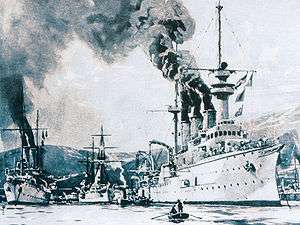 | ||||||||||||||||||||||||||||||||
|
||||||||||||||||||||||||||||||||
The Serbian military conspiracy was organized by Chief of Serbian Military Intelligence Dragutin Dimitrijević with the assistance of Major Vojislav Tankosić and spy Rade Malobabić. Tankosić armed the assassins with bombs and pistols and trained them. The assassins were given access to the same clandestine network of safe-houses and agents that Malobabić used for the infiltration of weapons and operatives into Austria-Hungary.
The assassins, the key members of the clandestine network, and the key Serbian military conspirators who were still alive were arrested, tried, convicted and punished. Those who were arrested in Bosnia were tried in Sarajevo in October 1914. The other conspirators were arrested and tried before a Serbian court on the French-controlled Salonika Front in 1916–1917 on unrelated false charges; Serbia executed three of the top military conspirators. Much of what is known about the assassinations comes from these two trials and related records.
While various countries of the former Yugoslavia largely view Gavrilo Princip as a terrorist,[1][2] the governments of Republika Srpska and Serbia continue to insist that Princip is a hero.[1][3]
Background
Under the 1878 Treaty of Berlin, Austria-Hungary received the mandate to occupy and administer the Ottoman Vilayet of Bosnia, while the Ottoman Empire retained official sovereignty. Under this same treaty, the Great Powers (Austria-Hungary, the United Kingdom, France, the German Empire, Italy, and the Russian Empire) gave official recognition to the Principality of Serbia as a fully sovereign state, which four years later transformed into a kingdom under Prince Milan IV Obrenović who thus became King Milan I of Serbia. Serbia's monarchs, at the time from the royal House of Obrenović that maintained close relations with Austria-Hungary, were content to reign within the borders set by the treaty.[4]
This changed in May 1903, when Serbian military officers led by Dragutin Dimitrijević stormed the Serbian Royal Palace. After a fierce battle in the dark, the attackers captured General Laza Petrović, head of the Palace Guard, and forced him to reveal the hiding place of King Alexander I Obrenović and his wife Queen Draga. The King and Queen opened the door from their hiding place. The King was shot thirty times; the Queen eighteen. MacKenzie writes that "the royal corpses were then stripped and brutally sabred."[5] The attackers threw the corpses of King Alexander and Queen Draga out of a palace window, ending any threat that loyalists would mount a counterattack."[6] General Petrović was then killed when Vojislav Tankosić organized the murders of Queen Draga's brothers.[7] The conspirators installed Peter I of the House of Karađorđević as the new king.[7]
The new dynasty was more nationalist, friendlier to Russia and less friendly to Austria-Hungary.[8] Over the next decade, disputes between Serbia and its neighbors erupted, as Serbia moved to build its power and gradually reclaim its 14th century empire. These conflicts included a customs dispute with Austria-Hungary beginning in 1906 (commonly referred to as the "Pig War");[9] the Bosnian crisis of 1908–1909, in which Serbia assumed an attitude of protest over Austria-Hungary's annexation of Bosnia-Herzegovina (ending in Serbian acquiescence without compensation in March 1909);[10] and finally the two Balkan Wars of 1912–1913, in which Serbia acquired Macedonia and Kosovo from the Ottoman Empire and drove out Bulgaria.[11]
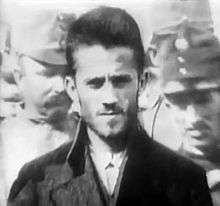
Serbia's military successes and Serbian outrage over the Austro-Hungarian annexation of Bosnia-Herzegovina emboldened Serbian nationalists in Serbia and Serbs in Austria-Hungary who chafed under Austro-Hungarian rule and whose nationalist sentiments were stirred by Serb "cultural" organizations.[12][13] One notable example was a Serbian nationalist society Narodna Odbrana, which was formed in Belgrade on 8 October 1908 under the initiative of Milovan Milovanović. Under the guise of cultural activities, it operated to undermine the loyalty of Serbs in Austria-Hungary to the Habsburg regime.[14][15] In the five years leading up to 1914, lone assassins – mostly Serb citizens of Austria-Hungary – made a series of unsuccessful assassination attempts in Croatia and Bosnia-Herzegovina against Austro-Hungarian officials.[16] In Bosnia-Herzegovina, there existed a local revolutionary movement known as Young Bosnia, whose goal was the dissolution of Austria-Hungary.[17][18]
On 3 June 1910, Bogdan Žerajić, a member of the Young Bosnia movement, attempted to kill the Austrian governor of Bosnia-Herzegovina, General Marijan Varešanin.[18] Žerajić was a 22-year-old Orthodox Serb from Nevesinje, Herzegovina, who was a student at the Faculty of Law at the University of Zagreb and made frequent trips to Belgrade.[19] (General Verešanin went on to crush the last Bosnian peasant uprising in the second half of 1910).[20] The five bullets Žerajić fired at Varešanin and the fatal bullet he put in his own brain made Žerajić an inspiration to future assassins, including Princip and Princip's accomplice Čabrinović. Princip said that Žerajić "was my first model. When I was seventeen I passed whole nights at his grave, reflecting on our wretched condition and thinking of him. It is there that I made up my mind sooner or later to perpetrate an outrage."[21]
In May 1911, the Black Hand, a secret society dedicated to create a Greater Serbia through "terrorist action", was established by key members of the Narodna Odbrana including Dimitrijević and Tankosić.[22][23] Within Bosnia-Herzegovina, the networks of both the Black Hand and Narodna Odbrana penetrated local revolutionary movements such as Young Bosnia.[18]
In 1913, Emperor Franz Joseph commanded Archduke Franz Ferdinand to observe the military maneuvers in Bosnia scheduled for June 1914.[24] Following the maneuvers, Ferdinand and his wife planned to visit Sarajevo to open the state museum in its new premises there.[25] Duchess Sophie, according to their eldest son, Duke Maximilian, accompanied her husband out of fear for his safety.[26]
As Sophie, although of high aristocratic birth, was not from a dynastic family, her union with the Habsburg heir presumptive could only be a morganatic marriage. Emperor Franz Joseph had only consented to their marriage on the condition that their descendants would never ascend the throne. The 14th anniversary of their marriage fell on 28 June. As historian A. J. P. Taylor observes:

[Sophie] could never share [Franz Ferdinand's] rank ... could never share his splendours, could never even sit by his side on any public occasion. There was one loophole ... his wife could enjoy the recognition of his rank when he was acting in a military capacity. Hence, he decided, in 1914, to inspect the army in Bosnia. There, at its capital Sarajevo, the Archduke and his wife could ride in an open carriage side by side ... Thus, for love, did the Archduke go to his death.[27]
Franz Ferdinand was an advocate of increased federalism and widely believed to favor trialism, under which Austria-Hungary would be reorganized by combining the Slavic lands within the Austro-Hungarian empire into a third crown.[28] A Slavic kingdom could have been a bulwark against Serb irredentism, and Franz Ferdinand was therefore perceived as a threat by those same irredentists.[29] Princip later stated to the court that preventing Franz Ferdinand's planned reforms was one of his motivations.[30]
The day of the assassination, 28 June (15 June in the Julian calendar), is the feast of St. Vitus. In Serbia, it is called Vidovdan and commemorates the 1389 Battle of Kosovo against the Ottomans, at which the Sultan was assassinated in his tent by a Serb.[31]
Preliminaries
Planning direct action
Danilo Ilić was a Bosnian Orthodox Serb. He had worked as a school teacher and as a bank worker but in 1913 and 1914 he lived with, and outwardly off, his mother, who operated a small boarding house in Sarajevo. Secretly, Ilić was leader of the Serbian-irredentist Black Hand cell in Sarajevo. In late 1913, Danilo Ilić came to the Serbian listening post at Užice to speak to the officer in charge, Serbian Colonel C. A. Popović, who was a captain at the time and a member of the Black Hand. Ilić recommended an end to the period of revolutionary organization building and a move to direct action against Austria-Hungary. Popović passed Danilo Ilić on to Belgrade to discuss this matter with Chief of Serbian Military Intelligence Colonel Dragutin Dimitrijević, known more commonly as Apis.[32] By 1913, Apis and his fellow military conspirators (drawn heavily from the ranks of the May 1903 coup) had come to dominate what was left of the Black Hand.[33]
There are no reports as to what took place between Ilić and Apis, but soon after their meeting, Apis's righthand man and fellow Black Hander, Serbian Major Vojislav Tankosić, who by this time was in charge of guerrilla training, called a Serbian irredentist planning meeting in Toulouse, France.[34] Amongst those summoned to the Toulouse meeting was Muhamed Mehmedbašić, a carpenter by trade and son of an impoverished Muslim noble from Herzegovina.[35] He too was a member of the Black Hand, having been sworn into the organization by Black Hand Provincial Director for Bosnia-Herzegovina Vladimir Gacinović and Danilo Ilić. Mehmedbašić was (here quoting Albertini paraphrasing Mehmedbašić) "eager to carry out an act of terrorism to revive the revolutionary spirit of Bosnia."[36] During this January 1914 meeting, various possible Austro-Hungarian targets for assassination were discussed, including Franz Ferdinand. However, the participants decided only to dispatch Mehmed Mehmedbašić to Sarajevo, to kill the Governor of Bosnia, Oskar Potiorek.[36]
While Mehmedbašić was travelling to Bosnia-Herzegovina from France, police searched his train for a thief. Thinking the police might be after him, he threw his weapons (a dagger and a bottle of poison) out the train window.[36] Once he arrived in Bosnia-Herzegovina he had to set about looking for replacement weapons.
Franz Ferdinand chosen
The search for new weapons delayed Mehmedbašić's attempt on Potiorek. Before Mehmedbašić was ready to act, Ilić summoned him to Mostar. On 26 March 1914,[37] Ilić informed Mehmedbašić that Belgrade had scrapped the mission to kill the governor. The plan now was to murder Franz Ferdinand, and Mehmedbašić should stand by for the new operation.[38] (Apis confessed to the Serbian Court that he ordered the assassination of Franz Ferdinand in his position as head of the Intelligence Department.)[39]
Ilić recruited the Serbian youths Vaso Čubrilović and Cvjetko Popović shortly after Easter (Orthodox Easter as given by Dedijer: 19 April 1914), for the assassination, as evidenced by the testimony of Ilić, Čubrilović, and Popović at the Sarajevo trial.[40] Three youths – Gavrilo Princip,[41] Trifko Grabež,[42] and Nedeljko Čabrinović[43] – Bosnian Serb subjects of Austria-Hungary, living in Belgrade, testified at the Sarajevo trial that at about the same time (a little after Easter), they were eager to carry out an assassination and approached a fellow Bosnian Serb and former guerrilla fighter known to be well connected and with access to arms, Milan Ciganović, and through him Major Tankosić and reached an agreement to transport arms to Sarajevo and participate in the assassination.
Agreement in principle was quickly reached, but delivery of the weapons was delayed for more than a month. The assassins would meet with Ciganović and he would put them off. At one point, Ciganović told Grabež: "Nothing doing, the old Emperor is ill and the Heir Apparent [sic] will not go to Bosnia."[44] When Emperor Franz Joseph's health recovered the operation was a "go" again. Tankosić gave the assassins one FN Model 1910 pistol. They practiced shooting a few rounds of scarce and expensive .380 ACP pistol ammunition in a park near Belgrade.[45]
The rest of the weapons were finally delivered on 26 May.[46] The three assassins from Belgrade testified that Major Tankosić, directly and through Ciganović, not only provided six hand grenades and four new Browning FN Model 1910 automatic pistols with .380 ACP ammunition,[45] but also money,[46] suicide pills,[47] training,[42] a special map with the location of gendarmes marked,[48] knowledge of contacts on a clandestine tunnel used to infiltrate agents and arms into Austria-Hungary,[49] and a small card authorizing the use of that tunnel.[50] Major Tankosić confirmed to the journalist and historian Luciano Magrini that he provided the bombs and pistols and was responsible for training Princip, Grabež, and Čabrinović and that he (Tankosić) initiated the idea of the suicide pills.[51]
Tunnel

Princip, Grabež, and Čabrinović left Belgrade by boat on 28 May and traveled along the Sava River to Šabac where they handed the small card to Captain Popović of the Serbian Border Guard. Popović, in turn, provided them with a letter to Serbian Captain Prvanović, and filled out a form with the names of three customs officials whose identities they could assume and thereby receive discounted train tickets for the ride to Loznica, a small border town.[52][53]
When Princip, Grabež, and Čabrinović reached Loznica on 29 May, Captain Prvanović summoned three of his revenue sergeants to discuss the best way to cross the border undetected. While waiting for the sergeants to arrive, Princip and Grabež had a falling out with Čabrinović over Čabrinović's repeated violations of operational security.[54] Čabrinović handed over the weapons he was carrying to Princip and Grabež. Princip told Čabrinović to go alone to Zvornik, make an official crossing there using Grabež's ID card and then go on to Tuzla and link back up.[55]
On the morning of 30 May Prvanović's revenue sergeants assembled and Sergeant Budivoj Grbić accepted the task and led Princip and Grabež by foot to Isaković's Island, a small island in the middle of the Drina River that separated Serbia from Bosnia. They and their weapons reached the island on 31 May. Grbić passed the terrorists and their weapons to the agents of the Serbian Narodna Odbrana for transport into Austro-Hungarian territory and from safe-house to safe-house. Princip and Grabež crossed into Austria-Hungary on the evening of 1 June.[56] Princip and Grabež and the weapons were passed from agent to agent until on 3 June they arrived in Tuzla. They left the weapons in the hands of the Narodna Odbrana agent Miško Jovanović and rejoined Čabrinović.[57]
The Narodna Odbrana agents reported their activities to the Narodna Odbrana President, Boža Janković, who in turn reported to the then Serbian Caretaker Prime Minister Nikola Pašić.[58] The report to Pašić added the name of a new military conspirator, Serbian Major Kosta Todorović, Boundary Commissioner and Director of Serbian Military Intelligence Services for the frontier line from Rada to Ljubovija. Pašić's handwritten notes from the briefing (estimated by Dedijer to have taken place on 5 June) included the nickname of one of the assassins ("Trifko" Grabež) and also the name of Major Tankosić.[59] The Austrians later captured the report, Pašić's handwritten notes, and additional corroborating documents.[60]
Čabrinović's father was a Sarajevo police official. In Tuzla, Čabrinović bumped into one of his father's friends, Sarajevo Police Detective Ivan Vila, and struck up a conversation. By coincidence, Princip, Grabež and Čabrinović boarded the same train for Sarajevo as Detective Vila. Čabrinović inquired of the detective the date of Franz Ferdinand's visit to Sarajevo. The next morning, Čabrinović passed on the news to his fellow assassins that the assassination would be on 28 June.[61]
On arriving in Sarajevo on 4 June, Princip, Grabež, and Čabrinović went their separate ways. Princip checked in with Ilić, visited his family in Hadžici and returned to Sarajevo on 6 June taking up residence at Ilić's mother's house with Ilić.[62] Grabež joined his family in Pale. Čabrinović moved back into his father's house in Sarajevo.[63]
On 14 June, Ilić went to Tuzla to bring the weapons to Sarajevo. Miško Jovanović hid the weapons in a large box of sugar. On 15 June, the two went separately by train to Doboj where Jovanović handed off the box to Ilić.[64] Later that day, Ilić returned to Sarajevo by train, being careful to transfer to a local train outside Sarajevo and then quickly transfer to a tram to avoid police detection. Once at his mother's house, Ilić hid the weapons in a suitcase under a sofa.[65] Then, on approximately 17 June, Ilić traveled to Brod (Dedijer puts it on 16 June, but trial records put it on 18 June). Questioned at trial, Ilić gave a confused explanation of the reason for his trip, first saying he had gone to Brod to prevent the assassination and then saying he had returned to Sarajevo from Brod to prevent the assassination.[66] Dedijer puts forward the thesis (citing Bogijević) that Ilić went to Brod to meet an emissary of Apis, Djuro Ŝarac, who had instructions to cancel the assassination and then later Rade Malobabić was dispatched from Serbia to Sarajevo to reauthorize the assassination.[67]
Eve of the attacks
Ilić began handing out the weapons on 27 June. Until 27 June Ilić had kept the identities of the assassins from Belgrade secret from those he had recruited locally and vice versa. Then, that night, as Mehmedbašić told Albertini: "On the eve of the outrage Ilić introduced me to Princip in a Sarajevo café with the words 'Mehmedbašić who to-morrow is to be with us.'"[30] The three sent a postcard to Black Hand Provincial Director for Bosnia-Herzegovina Vladimir Gaćinović in France.[30]
The following morning, on 28 June 1914, Ilić positioned the six assassins along the motorcade route. Ilić walked the street, exhorting the assassins to bravery.[30]
Assassination

Motorcade
On the morning of 28 June 1914, Franz Ferdinand and his party proceeded by train from Ilidža Spa to Sarajevo.[25] Governor Oskar Potiorek met the party at Sarajevo station. Six automobiles were waiting. By mistake, three local police officers got into the first car with the chief officer of special security; the special security officers who were supposed to accompany their chief got left behind.[68] The second car carried the Mayor and the Chief of Police of Sarajevo. The third car in the motorcade was a Gräf & Stift 28/32 PS open sports car with its top folded down. Franz Ferdinand, Sophie, Governor Potiorek, and Lieutenant Colonel Count Franz von Harrach rode in this third car.[68] The motorcade's first stop on the preannounced program was for a brief inspection of a military barracks. According to the program, at 10:00 a.m., the motorcade was to leave the barracks for the town hall by way of the Appel Quay.[69]
Security arrangements within Sarajevo were limited. The local military commander, General Michael von Appel, proposed that troops line the intended route but was told that this would offend the loyal citizenry. Protection for the visiting party was accordingly left to the Sarajevo police, of whom only about 60 were on duty on the Sunday of the visit.[70]
Bombing
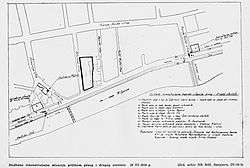
The motorcade passed the first assassin, Mehmedbašić. Danilo Ilić had placed him in front of the garden of the Mostar Cafe and armed him with a bomb.[71] Mehmedbašić failed to act. Ilić had placed Vaso Čubrilović next to Mehmedbašić, arming him with a pistol and a bomb. He too failed to act. Further along the route, Ilić had placed Nedeljko Čabrinović on the opposite side of the street near the Miljacka River, arming him with a bomb.
At 10:10 am,[72] Franz Ferdinand's car approached and Čabrinović threw his bomb. The bomb bounced off the folded back convertible cover into the street.[73] The bomb's timed detonator caused it to explode under the next car, putting that car out of action, leaving a 1-foot-diameter (0.30 m), 6.5-inch-deep (170 mm) crater,[72] and wounding 16–20 people.[74]
Čabrinović swallowed his cyanide pill and jumped into the Miljacka river. Čabrinović's suicide attempt failed, as the old cyanide only induced vomiting, and the Miljacka was only 13 cm deep due to the hot, dry summer.[75] Police dragged Čabrinović out of the river, and he was severely beaten by the crowd before being taken into custody.
The procession sped away towards the Town Hall leaving the disabled car behind. Cvjetko Popović, Gavrilo Princip, and Trifun Grabež failed to act as the motorcade passed them at high speed.[76]
Town Hall reception
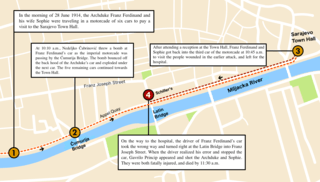
Arriving at the Town Hall for a scheduled reception, Franz Ferdinand showed understandable signs of stress, interrupting a prepared speech of welcome by Mayor Fehim Curčić to protest: "Mr. Mayor, I came here on a visit and I am greeted with bombs. It is outrageous."[77] Duchess Sophie then whispered into Franz Ferdinand's ear, and after a pause, Franz Ferdinand said to the mayor: "Now you may speak."[72] He then became calm and the mayor gave his speech. Franz Ferdinand had to wait as his own speech, still wet with blood from being in the damaged car, was brought to him. To the prepared text he added a few remarks about the day's events thanking the people of Sarajevo for their ovations "as I see in them an expression of their joy at the failure of the attempt at assassination."[78]
Officials and members of the Archduke's party discussed what to do next. The archduke's chamberlain, Baron Rumerskirch, proposed that the couple remain at the Town Hall until troops could be brought into the city to line the streets. Governor-General Oskar Potiorek vetoed this suggestion[79] on the grounds that soldiers coming straight from maneuvers would not have the dress uniforms appropriate for such duties. "Do you think that Sarajevo is full of assassins?" he concluded.[79]
Franz Ferdinand and Sophie gave up their planned program in favor of visiting the wounded from the bombing, at the hospital. Count Harrach took up a position on the left-hand running board of Franz Ferdinand's car to protect the Archduke from any assault from the riverside of the street.[80][81] This is confirmed by photographs of the scene outside the Town Hall. At 10:45 a.m, Franz Ferdinand and Sophie got back into the motorcade, once again in the third car.[80] In order to ensure the safety of the couple, General Oskar Potiorek decided that the imperial motorcade should travel straight along the Appel Quay to the Sarajevo Hospital so that they could avoid the crowded city center.[82][83] However, Potiorek failed to communicate his decision to the drivers.[81][84] As a result, the Archduke's driver, Leopold Lojka,[85] took a right turn at the Latin Bridge just as the two drivers ahead of him.[86] According to the historian Joachim Remak, the reason for this is that Potiorek's aide Eric(h) von Merrizzi was in the hospital, and was therefore unable to give Lojka the information about the change in plans and the driving route.[87] The Sarajevo Chief of Police Edmund Gerde, who had earlier repeatedly warned Potiorek of insufficient security precautions for the imperial visit, was asked by one of the Archduke’s aides to tell the drivers of the new route, but in the confusion and tensions of the moment, he neglected to do so.[88]
Fatal shooting
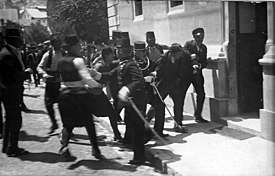
.jpg)
After learning that the first assassination attempt had been unsuccessful, Princip thought about a position to assassinate the Archduke on his return journey, and decided to move to a position in front of a nearby food shop (Schiller's delicatessen), near the Latin Bridge.[90] At this point, the first and second cars of the Archduke's motorcade suddenly turned right into a side street, leaving the Appel Quay.[86] When the Archduke’s driver followed their route, Governor Potiorek, who was sharing the third vehicle with the Imperial couple, called out to the driver to stop as he was going the wrong way.[91] As the driver applied the brakes to stop the car close to where Princip was standing,[91] the assassin stepped up to the footboard of the car, and shot Franz Ferdinand and Sophie at point‐blank range[91] using a Belgian-made Fabrique Nationale model 1910 .380 caliber pistol.[92] Pistol serial numbers 19074, 19075, 19120 and 19126 were supplied to the assassins; Princip used #19074.[93] According to Albertini, "the first bullet wounded the Archduke in the jugular vein, the second inflicted an abdominal wound on the Duchess."[94] Princip tried to shoot himself, but was immediately seized and arrested.[91] At his sentencing, Princip stated that his intention had been to kill Governor Potiorek, rather than Sophie.[95]
After being shot, Sophie immediately fell unconscious and collapsed onto Franz Ferdinand’s legs.[91] The Archduke, too, lost consciousness while being driven to the Governor's residence for medical treatment.[91] As reported by Count Harrach, Franz Ferdinand's last words were "Sophie, Sophie! Don't die! Live for our children!" followed by six or seven utterances of "It is nothing," in response to Harrach's inquiry as to Franz Ferdinand's injury.[96] These utterances were followed by a violent choking sound caused by hemorrhage.[84] The imperial couple were dead by 11:30 a.m on 28 June 1914;[97] Sophie was dead on arrival at the Governor's residence, and Franz Ferdinand died 10 minutes later.[98]
Funeral
The bodies were transported to Trieste by the battleship SMS Viribus Unitis and then to Vienna by special train. Even though most foreign royalty had planned to attend, they were pointedly disinvited and the funeral was just the immediate imperial family, with the dead couple's three children excluded from the few public ceremonies. The officer corps was forbidden to salute the funeral train, and this led to a minor revolt led by Archduke Karl, the new heir presumptive. The public viewing of the coffins was curtailed severely and even more scandalously, Montenuovo tried unsuccessfully to make the children foot the bill. The Archduke and Duchess were interred at Artstetten Castle because the Duchess could not be buried in the Imperial Crypt.[99]
Aftermath

All of the assassins were eventually caught.[100] Those in Austro-Hungarian custody were tried together with members of the infiltration route who had helped deliver them and their weapons to Sarajevo. Mehmedbašić was arrested in Montenegro, but was allowed to "escape" to Serbia where he joined Major Tankosić's auxiliaries,[101] but in 1916 Serbia imprisoned him on other false charges (see criminal penalty section below).
Anti-Serb rioting broke out in Sarajevo and various other places within Austria-Hungary in the hours following the assassination until order was restored by the military.[102] On the night of the assassination, country-wide anti-Serb pogroms and demonstrations were also organized in other parts of the Austro-Hungarian Empire, particularly on the territory of modern-day Bosnia and Herzegovina and Croatia.[103][104][105] They were organized and stimulated by Oskar Potiorek, the Austro-Hungarian governor of Bosnia and Herzegovina.[106] The first anti-Serb demonstrations, led by the followers of Josip Frank, were organized in early evening of 28 June in Zagreb. The following day, anti-Serb demonstrations in Sarajevo became more violent and could be characterized as a pogrom. The police and local authorities in the city did nothing to prevent anti-Serb violence.[107] Writer Ivo Andrić referred to the violence in Sarajevo as the "Sarajevo frenzy of hate."[108] Two Serbs were killed on the first day of pogrom in Sarajevo, many were attacked, while around 1,000 houses, shops, schools and institutions (such as banks, hotels, printing houses) owned by Serbs were razed or pillaged.[109]
Following the assassination, Franz Joseph's daughter, Marie Valerie, noted that her father expressed his greater confidence in the new heir presumptive, his grandnephew Archduke Charles. The emperor admitted to his daughter, regarding the assassination: "For me, it is a relief from a great worry."[110]
Trials and punishment
Sarajevo trial (October 1914)
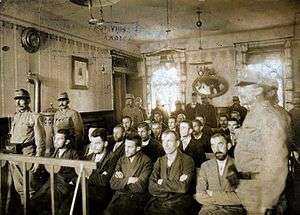
Austro-Hungarian authorities arrested and prosecuted the Sarajevo assassins (except for Mehmedbašić who had escaped to Montenegro and was released from police custody there to Serbia)[111] together with the agents and peasants who had assisted them on their way. The majority of the defendants were charged with conspiracy to commit high treason involving official circles in the Kingdom of Serbia.[14] Conspiracy to commit high treason carried a maximum sentence of death which conspiracy to commit simple murder did not. The trial was held from 12 to 23 October with the verdict and sentences announced on 28 October 1914.[14]
The adult defendants, facing the death penalty, portrayed themselves at trial as unwilling participants in the conspiracy. The examination of defendant Veljko Cubrilović (who helped coordinate the transport of the weapons and was a Narodna Odbrana agent) is illustrative of this effort. Cubrilović stated to the court: "Princip glared at me and very forcefully said 'If you want to know, it is for that reason and we are going to carry out an assassination of the Heir and if you know about it, you have to be quiet. If you betray it, you and your family will be destroyed.'"[112] Under questioning by defense counsel Cubrilović described in more detail the basis of the fears that he said had compelled him to cooperate with Princip and Grabež."[113] Cubrilović explained that he was afraid a revolutionary organization capable of committing great atrocities stood behind Princip and that he therefore feared his house would be destroyed and his family killed if he did not comply and explained that he knew such an organization existed in Serbia, at least at one time. When pressed for why he risked the punishment of the law, and did not take the protection of the law against these threats he responded: "I was more afraid of terror than the law."[113] Another Narodna Odbrana agent, Mihajlo Jovanović, also claimed to have been against the assassination.[14]
In order to refute the charge, the conspirators from Belgrade, who because of their youth did not face the death penalty, focused during the trial on putting blame on themselves and deflecting it from official Serbia and modified their court testimony from their prior depositions accordingly.[114] Princip stated under cross examination: "I am a Yugoslav nationalist and I believe in unification of all South Slavs in whatever form of state and that it be free of Austria." Princip was then asked how he intended to realize his goal and responded: "By means of terror."[115] Cabrinović, though, testified that the political views that motivated him to kill Franz Ferdinand were views held in the circles he traveled in within Serbia.[21] The court did not believe the defendants' stories claiming to hold official Serbia blameless.[116] The verdict ran: "The court regards it as proved by the evidence that both the Narodna Odbrana and military circles in the Kingdom of Serbia in charge of the espionage service, collaborated in the outrage."[116]
Prison terms, death sentences and acquittals were as follows:[117]
Name Sentence Gavrilo Princip 20 years Nedjelko Čabrinović 20 years Trifun Grabež 20 years Vaso Čubrilović 16 years Cvjetko Popović 13 years Lazar Đukić 10 years Danilo Ilić Death by hanging (executed 3 February 1915) Veljko Čubrilović Death by hanging (executed 3 February 1915) Neđo Kerović Death by hanging; commuted to 20 years in prison by Kaiser Franz-Joseph based on recommendation of the Finance Minister Mihajlo Jovanović Death by hanging (executed 3 February 1915) Jakov Milović Death by hanging; commuted to life in prison by Kaiser Franz-Joseph based on recommendation of the court and Finance Minister Mitar Kerović Life in prison Ivo Kranjcević 10 years Branko Zagorac 3 years Marko Perin 3 years Cvijan Stjepanović 7 years Nine defendants Acquitted
At trial Čabrinović had expressed his regrets for the murders. Following sentencing, Čabrinović received a letter of complete forgiveness from the three young children the assassins had orphaned.[118] Čabrinović and Princip died of tuberculosis in prison. Those under the age of 20 years at the time of the crime could receive a maximum sentence of 20 years under Austrian-Hungarian law. The court heard arguments regarding Princip's age, as there was some doubt as to his true date of birth but concluded that Princip was under 20 at the time of the assassination.[119] Because Bosnia and Herzegovina had not yet been assigned to Austria or to Hungary, the Austro-Hungarian Finance Minister administered Bosnia and Herzegovina and had responsibility for recommending clemency to the Kaiser.
Salonika trial (spring 1917)
In late 1916 and early 1917, secret peace talks took place between Austria-Hungary and France. There is circumstantial evidence that parallel discussions were held between Austria-Hungary and Serbia with Prime Minister Pašić dispatching his righthand man Stojan Protić and Regent Alexander dispatching his confidant[120] Colonel Petar Živković to Geneva on secret business.[121] Charles I of Austria laid out Austria-Hungary's key demand for returning Serbia to the control of the Serbian Government in exile: that Serbia should provide guarantees that there be no further political agitation emanating from Serbia against Austria-Hungary.[122]
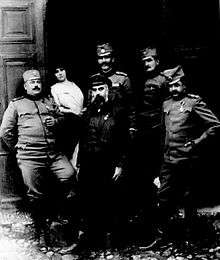
For some time, Regent Alexander and officers loyal to him had planned to get rid of the military clique headed by Apis as Apis represented a political threat to Alexander's power.[123] The Austro-Hungarian peace demand gave added impetus to this plan. On 15 March 1917 Apis and the officers loyal to him were indicted, on various false charges unrelated to Sarajevo (the case was retried before the Supreme Court of Serbia in 1953 and all defendants were exonerated),[124] by Serbian Court Martial on the French-controlled Salonika front. On 23 May Apis and eight of his associates were sentenced to death; two others were sentenced to 15 years in prison. One defendant died during the trial and the charges against him were dropped. The Serbian High Court reduced the number of death sentences to seven. Regent Alexander commuted four of the remaining death sentences, leaving just three death sentences in place.[125] Amongst those tried, four of the defendants had confessed their roles in Sarajevo and their final sentences were as follows:[126]
| Name | Sentence |
|---|---|
| Apis | Death by firing squad (executed 26 June 1917) and 70 dinar court fee and additional witness fees |
| Ljuba Vulović | Death by firing squad (executed 26 June 1917) and 70 dinar court fee and additional witness fees |
| Rade Malobabić | Death by firing squad (executed 26 June 1917) and 70 dinar court fee and additional witness fees |
| Muhamed Mehmedbašić | 15 years prison (commuted and released in 1919) and 60 dinar court fee and additional witness fees |
In justifying the executions, Prime Minister Pašić wrote to his envoy in London:"...Dimitrijević (Apis) besides everything else admitted he had ordered Franz Ferdinand to be killed. And now who could reprieve them?"[127]
As the three condemned men were driven to their execution, Apis remarked to the driver "Now it is clear to me and clear to you too, that I am to be killed today by Serbian rifles solely because I organized the Sarajevo outrage.[128]
Vojislav Tankosić died in battle in late 1915 and so was not put on trial.[129]
Controversy about responsibility
Serbia's "warning" to Austria-Hungary
Following the assassinations, Serbian Ambassador to France Milenko Vesnić and Serbian Ambassador to Russia Miroslav Spalajković put out statements claiming that Serbia had warned Austria-Hungary of the impending assassination.[130] Serbia soon thereafter denied making warnings and denied knowledge of the plot. Prime Minister Pašić himself made these denials to Az Est on 7 July and to the Paris Edition of the New York Herald on 20 July.[131] Other voices eventually spoke out on the "warning". As Serbian Education Minister Ljuba Jovanović wrote in Krv Sloventsva, in late May or early June, Prime Minister Pašić reviewed the plot of the impending assassination with members of his cabinet.[132] On 18 June, a telegram, lacking in specifics, ordered Serbia's Ambassador to Vienna, Jovan Jovanović, to warn Austria-Hungary that Serbia had reason to believe there was a conspiracy to assassinate Franz Ferdinand in Bosnia.[133] On 21 June, Ambassador Jovanović met with Austro-Hungarian Finance Minister Bilinski. According to Serbian Military Attaché to Vienna, Colonel Lesanin, Ambassador Jovanović, spoke to Bilinski and "...stressed in general terms the risks the Archduke heir apparent [sic] might run from the inflamed public opinion in Bosnia and Serbia. Some serious personal misadventure might befall him. His journey might give rise to incidents and demonstrations that Serbia would deprecate but that would have fatal repercussions on Austro-Serbian relations."[134] Jovanović came back from the meeting with Bilinski and told Lesanin that "...Bilinski showed no sign of attaching great importance to the total message and dismissed it limiting himself to remarking when saying goodbye and thanking him: 'Let us hope nothing does happen.'"[135] The Austro-Hungarian Finance Minister took no action based on Jovanović's remarks.
In 1924 J. Jovanović went public stating that his warning had been made on his own initiative, and what he said was that "Among the Serb youths (in the army) there may be one who will put a ball-cartridge in his rifle or revolver in place of a blank cartridge and he may fire it, the bullet might strike the man giving provocation (Franz Ferdinand)."[136] J. Jovanović's account changed back and forth over the years and never adequately addressed Colonel Lesanin's statement.[137] Bilinski did not speak openly on the subject, but his press department chief confirmed that a meeting had taken place including a vague warning, but there was no mention of an ethnic Serb Austro-Hungarian soldier shooting Franz Ferdinand.[136]
In the days leading up to the assassination, Pašić was caretaker prime minister because during this period the Serbian Government briefly fell to a political alliance led by the Serbian Military. The military favored promoting Jovan Jovanović to Foreign Minister,[138] and Jovanović's loyalties one might expect to have been divided and his orders therefore carried out poorly. By choosing a military loyalist to convey the message, and by not including any of the specifics such as the conspirators' names and weapons, Pašić, a survivor, hedged his bets against the various possible outcomes and consequences of the impending assassination.[139]
Rade Malobabić
In 1914, Rade Malobabić was Serbian Military Intelligence's chief undercover operative against Austria-Hungary. His name appeared in Serbian documents captured by Austria-Hungary during the war. These documents describe the running of arms, munitions, and agents from Serbia into Austria-Hungary under Malobabić's direction.[58]
Owing to the suppression by Serbia of Apis's confession and of the Salonika trial transcripts historians did not initially link Malobabić closely to the Sarajevo attack. Apis's confession, however, states that "I engaged Malobabić to organize the assassination on the occasion of the announced arrival of Franz Ferdinand to Sarajevo."[39] At the Salonika trial, Colonel Ljubomir Vulović (head of the Serbian Frontiers Service) testified: 'In 1914 on occasion of my official trip from Loznica to Belgrade, I received a letter at the General Staff [signed by Marshal Putnik, Serbia's top military officer] noting that agents of Malobabić would come and a teacher whose name I don't recall (Danilo Ilić was a teacher but it is unclear if the teacher in question was Ilić as Ilić can be placed in Brod but not Loznica) so I could sent [sic] them into Bosnia.' Because of that 'I went to Loznica and either that day or very soon afterwards sent Rade and that teacher into Bosnia.' Soon thereafter occurred the Sarajevo assassination of Archduke Franz Ferdinand."[140] On the eve of his execution, Malobabić told a priest: "They ordered me to go to Sarajevo when that assassination was to take place, and when everything was over, they ordered me to come back and fulfill other missions, and then there was the outbreak of the war."[141][142] Vladimir Dedijer in The Road to Sarajevo presented additional testimonial evidence that Malobabić arrived in Sarajevo on the eve of the Sarajevo attack and gave the final go ahead for the operation to Danilo Ilić.[143] This meshes with Dedijer's theory that Djuro Ŝarac had given instructions to Ilić on 16 June cancelling the assassination. Soon after their confessions, Serbia executed Malobabić, Vulović, and Apis on false charges. Serbia published no clarifications of their confessions with regards to the Sarajevo attack.
"Black Hand" or Serbian military intelligence?
An alternative theory to the Sarajevo attack being a Serbian Military Intelligence Operation was that it was a "Black Hand" operation. The "Black Hand" was a Serbian military society formed on 9 May 1911 by officers in the Army of the Kingdom of Serbia, originating in the conspiracy group that assassinated the Serbian royal couple in May 1903, led by captain Dragutin Dimitrijević (Commonly referred to as "Apis").[144]
After Serbia's victory over Bulgaria in Macedonia in the Balkan Wars, the "Black Hand" became moribund because of the death of its president and the failure to replace him, an inactive secretary, casualties, broken links between its three-man cells, and a drying up of funding.[145] By 1914 the "Black Hand" was no longer operating under its constitution but rather as a creature of the Chief of Serbian Military Intelligence, Apis, and its active ranks were composed mostly of Serbian officers loyal to Apis. Apis's confession to ordering the operation that begins with the phrase "As the Chief of the Intelligence Department of the General Staff",[39] the fact that the military chain of command was invoked, the moribund nature of the "Black Hand" and the fact that under the "Black Hand" constitution Article 16, such an assassination could only be ordered by a vote of the Supreme Council Directorate, the President or the Secretary and no such order was made,[146] are factors in favor of assigning responsibility to Serbian Military Intelligence. The fact that Milan Ciganović was involved, that the key officers involved were "Black Hand" members,[147][148] that "Black Hand" Provincial Director for Bosnia and Herzegovina Vladimir Gaćinović was consulted[149] and that there was no official budget for the operation favors assigning responsibility to the "Black Hand".
The newspaper clipping
At trial, it was noted that the three assassins from Belgrade tried to take all blame on themselves. Čabrinović claimed the idea of killing Franz Ferdinand came from a newspaper clipping he received in the mail at the end of March announcing Franz Ferdinand's planned visit to Sarajevo.[150] He then showed the newspaper clipping to Princip and the next day they agreed they would kill Franz Ferdinand. Princip explained to the court he had already read about Franz Ferdinand's upcoming visit in German papers.[151] Princip went on to testify that, at about the time of Easter (19 April), he wrote an allegorical letter to Ilić informing him of the plan to kill Franz Ferdinand.[152] Grabež testified that he and Princip, also at about the time of Easter, agreed between them to make an assassination of either Governor Potiorek or Franz Ferdinand and a little later settled on Franz Ferdinand.[153] The defendants refused or were unable to provide details under examination.
On 26 March Ilić and Mehmedbašić had already agreed to kill Franz Ferdinand based on instructions from Belgrade predating the newspaper clipping and the discussions amongst the three assassins in Belgrade.[37]
Narodna Odbrana
Serbian Military Intelligence – through remnants of the "Black Hand" – penetrated the Narodna Odbrana, using its clandestine tunnel to smuggle the assassins and their weapons from Belgrade to Sarajevo. In 5 June 1914 report by the President of the Narodna Odbrana Boža Milanović to Prime Minister Pašić one can sense the frustration of the President over the hijacking of his organization in the final sentence dealing with Sarajevo: "Boža has informed all the agents that they should not receive anyone unless he produces the password given by Boža."[60]
Milan Ciganović
Prime Minister Pašić received early information of the assassination plan. The information was received by Pašić early enough, according to Education Minister Ljuba Jovanović, for the government to order the border guards to prevent the assassins from crossing. This places the cabinet minister discussions in late May and the information release to some time before that.[154] Albertini concluded that the source of the information was most likely Milan Ciganović.[155] Bogičević made a more forceful case.
The circumstantial evidence against Ciganović includes his sinecure government job, his protection by the Chief of Police and Serbia's failure to arrest him (Austria-Hungary demanded Serbia arrest Major Vojislav Tankosić and Ciganović, but Serbia arrested only Tankosić and lied saying that Ciganović could not be found), Serbia's protection of Ciganović during the war, and the government's provision for Ciganović after it. In 1917, all of the Sarajevo conspirators within Serbia's control were tried at Salonika on false charges, except Ciganović, who even gave evidence against his comrades at the trial.
Russian military attaché's office
Apis's confession to ordering the assassination of Franz Ferdinand states that Russian Military Attaché Artamonov promised Russia's protection from Austria-Hungary if Serbia would ever come under attack. While admitting funding of intelligence network in Austro-Hungary, Artamonov denied the involvement of his office into assassination in an interview with Albertini. Artamonov stated that he went on vacation to Italy leaving Assistant Military Attaché Alexander Werchovsky in charge and though he was in daily contact with Apis he did not learn of Apis's role until after the war had ended.[156] Albertini writes that he "remained unconvinced by the behavior of this officer."[157] Werchovsky admitted the involvement of his office and then fell silent on the subject.[158]
There is evidence that Russia was at least aware of the plot before 14 June. De Schelking writes:
On 1 June 1914 (14 June new calendar), Emperor Nicholas had an interview with King Charles I of Roumania, at Constanza. I was there at the time ... yet as far as I could judge from my conversation with members of his (Russian Foreign Minister Sazonov's) entourage, he (Sazonov) was convinced that if the Archduke (Franz Ferdinand) were out of the way, the peace of Europe would not be endangered.[159]
Consequences
.jpg)
The murder of the heir to the Austro-Hungarian Empire and his wife produced widespread shock across European royal houses, and there was initially much sympathy for the Austrian position. Ordinary people did not really care about what happened, and on the evening of the assassination the crowds in Vienna listened to music and drank wine, as if nothing had happened.[161][162] Within two days of the assassination, Austria-Hungary and Germany advised Serbia that it should open an investigation, but Secretary General to the Serbian Ministry of Foreign Affairs Slavko Gruic, replied "Nothing had been done so far and the matter did not concern the Serbian Government." An angry exchange followed between the Austrian Chargé d'Affaires at Belgrade and Gruic.[163]
After conducting a criminal investigation, verifying that Germany would honor its military alliance, and persuading the skeptical Hungarian Count Tisza, Austria-Hungary issued a formal letter to the government of Serbia on 23 July 1914. The letter reminded Serbia of its commitment to respect the Great Powers' decision regarding Bosnia-Herzegovina, and to maintain good neighborly relations with Austria-Hungary. The letter contained specific demands that Serbia should accept, including the suppression of the publication of propaganda advocating the violent destruction of Austria-Hungary, the removal of the people behind this propaganda from the Serbian Military, the dissolution of the Serbian nationalist organization Narodna Odbrana, the arrest of the people on Serbian soil who were involved in the assassination plot and the prevention of the clandestine shipment of arms and explosives from Serbia to Austria-Hungary.[164][165] It also demanded that Austro-Hungarian officials should take part in the Serbian inquiry into the assassination plot.[165]
This letter became known as the July Ultimatum, and Austria-Hungary stated that if Serbia did not accept all of the demands in total within 48 hours, it would recall its ambassador from Serbia. After receiving a telegram of support from Russia, Serbia mobilized its army and responded to the letter by completely accepting point #8 demanding an end to the smuggling of weapons and punishment of the frontier officers who had assisted the assassins and completely accepting point #10 which demanded Serbia report the execution of the required measures as they were completed. Serbia partially accepted, finessed, disingenuously answered or politely rejected elements of the preamble and enumerated demands #1–7 and #9. The shortcomings of Serbia's response were published by Austria-Hungary. Austria-Hungary responded by breaking diplomatic relations.[166]
The next day, Serbian reservists being transported on tramp steamers on the Danube crossed onto the Austro-Hungarian side of the river at Temes-Kubin and Austro-Hungarian soldiers fired into the air to warn them off.[167] The report of this incident was initially sketchy and reported to Emperor Franz-Joseph erroneously as "a considerable skirmish".[168][169] Austria-Hungary then declared war and mobilized the portion of its army that would face the (already mobilized) Serbian Army on 28 July 1914. Under the Secret Treaty of 1892 Russia and France were obliged to mobilize their armies if any of the Triple Alliance mobilized. Russia partially mobilized along its Austrian border on 29 July, and on 30 July Russia ordered general mobilization.[170] Russia's general mobilization set off full Austro-Hungarian and German mobilizations. Soon all the Great Powers except Italy had chosen sides and gone to war.
Today

The consequences of his action were very bad for Bosnia. Bosnia ceased to exist in Yugoslavia, and Bosnian Muslims were not recognised until 1968. They were still much better rulers than the kingdom of Yugoslavia or communist Yugoslavia. You can look at the historical records and see how Austria-Hungary cared about issues like the rule of law. We lost so much in 1918.
— Fedzad Forto, editor of a Bosniak-Croat news agency, responding to claims that Princip helped liberate Bosnia and that Austria-Hungary was an occupying power.[2]
The shots fired 100 years ago by Gavrilo Princip were not fired at Europe, they were shots for freedom, marking the start of the Serbs' fight for liberation from foreign occupiers.
Later, referring to Franz Ferdinand's assassination, Vaso Čubrilović said: "We destroyed a beautiful world that was lost forever due to the war that followed."[172]
Various countries of the former Yugoslavia,[1] Bosniaks and Croats largely view Gavrilo Princip as a terrorist and an ethnic Serb nationalist.[2] The 100th anniversary of the assassination was commemorated with a concert by the Vienna Philharmonic in the Sarajevo City Hall, in an event that was organized by the European Union.[2] Austrian president Heinz Fischer was the guest of honour.[173]
The World War I commemorations were boycotted by Serb nationalists and dignitaries, who, along with Bosnian Serbs, view "Princip as a hero."[3] On the 100th anniversary of the assassination, a statue of Gavrilo Princip was erected in East Sarajevo.[2] This was followed by another statue in Belgrade, which was erected in June 2015.[174] Serbian history textbooks deny that Serbia or Princip were responsible for starting World War I,[1] laying blame on the Central Powers instead.[175] Milorad Dodik acknowledged that Bosnia is "still divided", but maintained that Princip was a "freedom fighter" and that Austria-Hungary had been an "occupier".[176]
Princip's weapon, along with the car in which the Archduke was riding, his bloodstained uniform and the chaise longue on which he died, are on permanent display in the Heeresgeschichtliches Museum in Vienna, Austria. The bullet fired by Gavrilo Princip, sometimes referred to as "the bullet that started World War I",[177] is a museum exhibit in the Konopiště Castle near the town of Benešov in the Czech Republic. The bronze medallion of Ferdinand and Sophie, which was part of a monument that was erected on the site of the assassination and demolished in 1918 during Yugoslav rule, is currently preserved in the Art Gallery of Bosnia and Herzegovina in Sarajevo.[178]
In popular culture
- 28 June 1914 is a 2019 Bosnian bestseller novel by Zlatko Topčić. The novel, in fact, deeply undermines any absolute "historical truth", shatters and destroys the myth of the last illusions about history and its "processes", about official versions of great events, about movements, revolutionaries, heroes, rebels, about "real" causes and occasions for wars, bringing a completely unusual story, devoid of any romantic-ideological enthusiasm, about the Bosnian man.[179]
See also
Notes
- "Gavrilo Princip: hero or villain?", The Guardian, 6 May 2014, retrieved 1 February 2018
- Gavrilo Princip: Bosnian Serbs remember an assassin, BBC News, 28 June 2014, retrieved 23 January 2018
- John F. Burns (29 June 2014), "Remembering World War I in the Conflict's Flash Point", The New York Times, retrieved 29 January 2018
- MacKenzie 1995, pp. 9–10.
- MacKenzie 1995, p. 22.
- MacKenzie 1995, pp. 22–23.
- MacKenzie 1995, pp. 23–24.
- MacKenzie 1995, pp. 24–33.
- MacKenzie 1995, p. 27.
- Albertini 2005, pp. 291–292.
- Albertini 2005, pp. 364–480.
- MacKenzie 1995, pp. 36–37.
- Albertini 1953, pp. 19–23.
- Biagini 2015, p. 21.
- Martel 2014, p. 58.
- Dedijer 1966, pp. 236–270.
- Biagini 2015, p. 20.
- Clark 2012, p. 69.
- Dedijer 1966, p. 243.
- Dedijer 1966, pp. 203–204.
- Albertini 1953, p. 50.
- Martel 2014, pp. 58–60.
- McMeekin 2013, p. 21.
- Dedijer 1966, p. 285.
- Dedijer 1966, p. 9.
- Dedijer 1966, p. 286.
- Taylor 1963, p. 13.
- Albertini 1953, pp. 11–17.
- Albertini 1953, pp. 87–88.
- Albertini 1953, p. 49.
- Isabelle Dierauer (16 May 2013). Disequilibrium, Polarization, and Crisis Model: An International Relations Theory Explaining Conflict. University Press of America. p. 88. ISBN 978-0-7618-6106-5.
- Albertini 1953, pp. 27–28; 79.
- MacKenzie 1995, p. 47.
- Albertini 1953, pp. 76–77.
- Dedijer 1966, p. 282.
- Albertini 1953, p. 78.
- Dedijer 1966, p. 283; Dedijer placed the meeting in Sarajevo, not Mostar.
- Albertini 1953, pp. 78–79; Note the date error: 25 July should read 25 June
- Dedijer 1966, p. 398.
- Owings 1984, pp. 117–118; 129–131; 140; 142.
- Owings 1984, pp. 58–59.
- Owings 1984, pp. 93–94.
- Owings 1984, pp. 26–28; 30.
- Albertini 1953, p. 56.
- Vanderlinden, Anthony (2014). "The FN Browning 1910 Pistol & The Great War". American Rifleman. National Rifle Association. 162 (September): 67–69.
- Owings 1984, p. 59.
- Owings 1984, p. 41; 46.
- Owings 1984, pp. 109–110.
- Owings 1984, p. 106.
- Owings 1984, p. 40; 59.
- Magrini 1929, pp. 94–95.
- Owings 1984, pp. 36–38.
- Dedijer 1966, p. 296.
- Dedijer 1966, pp. 295–297.
- Dedijer 1966, pp. 296–297.
- Dedijer 1966, p. 298.
- Owings 1984, pp. 61–64.
- Dedijer 1966, pp. 388–389.
- Dedijer 1966, p. 503.
- Dedijer 1966, p. 390; 505.
- Dedijer 1966, pp. 300–301.
- Dedijer 1966, p. 303.
- Dedijer 1966, p. 305.
- Owings 1984, pp. 185–186.
- Owings 1984, pp. 118–119.
- Owings 1984, p. 126.
- Dedijer 1966, p. 309.
- Dedijer 1966, p. 11.
- Dedijer 1966, p. 9; 12.
- King, Greg (2013). The Assassination of the Archduke. pp. 168–169. ISBN 978-1-4472-4521-6.
- Dedijer 1966, p. 313.
- Dedijer 1966, p. 12.
- Albertini 1953, p. 35.
- Dedijer 1966, Chapter XIV, footnote 21.
- Malmberg, Ilkka: Tästä alkaa maailmansota. Helsingin Sanomat monthly supplement, June 2014, pp. 60–65.
- Dedijer 1966, pp. 318–320; 344.
- Albertini 1953, pp. 36–37.
- Dedijer 1966, pp. 13–14.
- Buttar, Prit. Collision of Empires. p. 282. ISBN 978-1-78200-648-0.
- Dedijer 1966, p. 15.
- McMeekin 2013, p. 31.
- McMeekin 2013, p. 28.
- Biagini 2015, p. 19.
- Gerolymatos 2008, p. 40.
- "Time Magazine Milestones (as Leopold Lojka)". Time.com. 9 August 1926.
- MacMillan 2013, pp. 517–518.
- "Full text of "Sarajevo The Story of a Political Murder"". Retrieved 28 October 2013.
- King 2013, p. 169, 205.
- Butcher 2014, p. 277; Many sources describe this picture as showing Princip being arrested, but modern historians believe that the man was a bystander named Ferdinand Behr.
- Owings 1984, pp. 67–8.
- MacMillan 2013, p. 518.
- King 2013, p. 206.
- Belfield 2005, p. 237.
- Albertini 1953, p. 36.
- Dedijer 1966, p. 346.
- Albertini 1953, pp. 37–38.
- McMeekin 2013, p. 32.
- Albertini 1953, p. 38.
- "The Funeral of the Archduke". The Independent. New York. 13 July 1914. p. 59.
- Albertini 1953, p. 45.
- Documents Diplomatiques Francais III Serie 1911–14,3, X Doc. 537
- Albertini 1953, pp. 120–1.
- Reports Service: Southeast Europe series. American Universities Field Staff. 1964. p. 44.
... the assassination was followed by officially encouraged anti-Serb riots in Sarajevo and elsewhere and a country-wide pogrom of Serbs throughout Bosnia-Herzegovina and Croatia.
- Kasim Prohić; Sulejman Balić (1976). Sarajevo. Tourist Association. p. 1898.
Immediately after the assassination of 28th June, 1914, veritable pogroms were organised against the Serbs on the...
- Johnson 2007, p. 27.
- Novak, Viktor (1971). Istoriski časopis. p. 481.
Не само да Поћорек није спречио по- громе против Срба после сарајевског атентата већ их је и организовао и под- стицао.
- Mitrović 2007, p. 18.
- Gioseffi 1993, p. 246.
- Donia 2006, p. 125.
- Palmer 1994, p. 324.
- Documents Diplomatiques Francais III Serie 1911–14,3, X Doc. 537. This document notes that the diplomatic cable was forwarded to the Secret Service of the National Security Department to investigate the matter of the January 1914 irredentist planning meeting in France but the Secret Service did not report back.
- Owings 1984, p. 159.
- Owings 1984, p. 170.
- Albertini 1953, pp. 50–1.
- Owings 1984, p. 56.
- Albertini 1953, p. 68.
- Owings 1984, pp. 527–530.
- Dedijer 1966, pp. 345–346.
- Dedijer 1966, p. 343.
- MacKenzie 1995, p. 53.
- MacKenzie 1995, pp. 70–71.
- MacKenzie 1995, p. 72.
- MacKenzie 1995, pp. 56–64.
- MacKenzie 1995, p. 2.
- MacKenzie 1995, pp. 344–347.
- MacKenzie 1995, pp. 329; 344–347.
- MacKenzie 1995, p. 392.
- Albertini 1953, pp. 80–81.
- Magrini 1929, p. 95.
- Albertini 1953, pp. 100–101.
- Albertini 1953, p. 99.
- Albertini 1953, p. 90.
- Albertini 1953, p. 101.
- Albertini 1953, pp. 104–105.
- Magrini 1929, pp. 115–116.
- Albertini 1953, pp. 102–103.
- Albertini 1953, pp. 102–105.
- Albertini 1953, p. 106.
- Albertini 1953, pp. 106–109.
- MacKenzie 1995, pp. 241–242.
- Dedijer 1966, p. 399.
- MacKenzie 1995, p. 391.
- Dedijer 1966, p. 394.
- Pearson 2005, pp. 27–28, 585.
- MacKenzie 1995, pp. 133–134; 137; 143.
- MacKenzie 1995, p. 46.
- Craig 2005, p. 3.
- Remak 1971, p. 71.
- MacKenzie 1989, p. 135.
- Dedijer 1966, p. 289.
- Owings 1984, p. 57.
- Owings 1984, p. 65.
- Owings 1984, p. 89.
- Albertini 1953, p. 92.
- Albertini 1953, pp. 282–283.
- Albertini 1953, pp. 84–85.
- Albertini 1953, p. 85.
- Trydar-Burzinski 1926, p. 128.
- De Schelking 1918, pp. 194–195.
- "Austria Will Avenge Murder". The Winnipeg Tribune. 29 June 1914. p. 1.
- "European powers maintain focus despite killings in Sarajevo — History.com This Day in History". History.com. 30 June 1914.
- Willmott 2003, p. 26.
- Albertini 1953, p. 273.
- Albertini 1953, pp. 285–289.
- Joll 2013, pp. 15–16.
- Albertini 1953, p. 373.
- Albertini 1953, pp. 461–462; 465.
- Albertini 1953, p. 460.
- Manfried, Rauchensteiner. The First World War and the End of the Habsburg Monarchy, 1914–1918, p. 27 (Böhlau Verlag, Vienna, 2014).
- Tuchman 2009, p. 85.
- Simon Kuper (21 March 2014), "Sarajevo: the crossroads of history", Financial Times, retrieved 1 February 2018
- Sugar 1999, p. 70.
- Matt Robinson, Maja Zuvela (28 June 2014), Sarajevo recalls the gunshot that sent the world to war, Reuters, retrieved 30 January 2018
- Serbia: Belgrade's monument to Franz Ferdinand assassin, BBC News, 8 June 2015, retrieved 23 January 2018
- Nemanja Rujević (28 July 2014), Serbia, WWI, and the question of guilt, Deutsche Welle, retrieved 1 February 2018
- WWI centennial event without Serbs, Deutsche Welle, 28 June 2014, retrieved 1 February 2018
- "Show Business: THE ROAD". TIME. 14 November 1960.
- "Reconstruction of Medallions of Sarajevo Monument of Ferdinand and Sophie in Final Phase", Sarajevo Times, 8 April 2014, retrieved 1 February 2018
- "Zlatko Topčić: Odlomak iz romana „28. 6. 1914."". penbih.ba. 31 August 2019.
References
- Albertini, Luigi (1953). Origins of the War of 1914. II. Oxford: Oxford University Press. OCLC 168712.
- Albertini, Luigi (2005). Origins of the War of 1914. I. New York: Enigma Books. ISBN 1-929631-31-6.
- Belfield, Richard (2005). The Assassination Business: A History of State-Sponsored Murder. New York: Carroll & Graf. ISBN 0-7867-1343-7.
- Butcher, Tim (2014). The Trigger: Hunting the Assassin Who Brought the World to War. New York: Grove Press. ISBN 978-0-80219-188-5.
- Dedijer, Vladimir (1966). The Road to Sarajevo. New York: Simon and Schuster. OCLC 400010.
- MacKenzie, David (1995). Black Hand on Trial: Salonika 1917. Eastern European Monographs. ISBN 978-0-88033-320-7.
- Magrini, Luciano (1929). Il Dramma Di Seraievo. Origini e responsabilita della guerra europea. Milan. OCLC 8018932.
- Gioseffi, Daniela (1993). On Prejudice: A Global Perspective. Anchor Books. ISBN 978-0-385-46938-8.
- Owings, W.A. Dolph. (1984). The Sarajevo Trial. Chapel Hill, NC.: Documentary Publications. ISBN 0-89712-122-8.
- Donia, Robert J. (2006). Sarajevo: A Biography. University of Michigan Press. ISBN 978-0-472-11557-0.
- De Schelking, Eugene (1918). Recollections of a Russian Diplomat, The Suicide of Monarchies. New York: Macmillan Co. OCLC 1890657.
- Johnson, Wes (2007). Balkan Inferno: Betrayal, War and Intervention, 1990–2005. Enigma Books. ISBN 978-1-929631-63-6.
- Mitrović, Andrej (2007). Serbia's Great War, 1914–1918. Purdue University Press. ISBN 978-1-55753-477-4.
- Strachan, Hugh (2001). The First World War. I: To Arms. Oxford: Oxford University Press. ISBN 978-0-19-926191-8.
- Pearson, Owen (2005). Albania in the Twentieth Century, A History: Volume I: Albania and King Zog, 1908-39. I.B.Tauris. ISBN 9781845110130.
- Sugar, Peter F. (1999). East European Nationalism, Politics and Religion. Farnham, England: Ashgate Publishing. ISBN 978-0-86078-806-5.CS1 maint: ref=harv (link)
- Taylor, A. J. P. (1963). The First World War: An Illustrated History. London: Penguin Books. ISBN 0-14-002481-6.
- Trydar-Burzinski, Louis (1926). Le Crépuscule d'une Autocratie. Florence. OCLC 473403651.
- Craig, John S. (2005). Peculiar Liaisons: In War, Espionage, and Terrorism in the Twentieth Century. Algora Publishing. ISBN 0-87586-331-0.
- Remak, Joachim (1971). The First World War: Causes, Conduct, Consequences. Wiley. ISBN 0-471-71634-0.
- MacKenzie, David (1989). Apis, the Congenial Conspirator: the Life of Colonel Dragutin T. Dimitrijević. East European Monographs. ISBN 0-88033-162-3.
- Willmott, H. P. (2003). World War I. Dorling Kindersley. ISBN 978-0-7894-9627-0.CS1 maint: ref=harv (link)
- MacMillan, Margaret (2013). The War That Ended Peace: How Europe Abandoned Peace for the First World War. Profile Books. ISBN 9781847654168.
- Tuchman, Barbara (2009). The Guns of August: The Outbreak of World War I. Random House Publishing Group. ISBN 9780307567628.
- Biagini, Antonello; Motta, Giovanna (2015). The First World War: Analysis and Interpretation, Volume 1. Cambridge Scholars Publishing. ISBN 9781443881869.
- Martel, Gordon (2014). The Month that Changed the World: July 1914 and WWI. Oxford University Press. ISBN 9780191643279.
- Clark, Christopher (2012). The Sleepwalkers: How Europe Went to War in 1914. Penguin UK. ISBN 9780718192952.
- Joll, James; Martel, Gordon (2013). The Origins of the First World War (3rd ed.). Routledge. ISBN 9781317875369.
- McMeekin, Sean (2013). July 1914: Countdown to War. Hachette UK. ISBN 9781848316096.
- Gerolymatos, Andre (2008). The Balkan Wars. Hachette UK. ISBN 9780786724574.
- King, Greg; Woolmans, Sue (2013). The Assassination of the Archduke: Sarajevo 1914 and the Romance That Changed the World. St. Martin's Press. ISBN 9781250038678.
Further reading
- Bataković, Dušan T. (1996). The Serbs of Bosnia & Herzegovina: History and Politics. Dialogue Association. ISBN 9782911527104.CS1 maint: ref=harv (link)
- Fay, Sidney Bradshaw: Origins of the Great War. New York 1928
- Fomenko, A. "There Was an Alternative! The Legacy of Franz Ferdinand" International Affairs: A Russian Journal of World Politics, Diplomacy & International Relations (2009) 55#3 p177-184.
- Ponting, Clive. Thirteen Days, Chatto & Windus, London, 2002.
- Stoessinger, John. Why Nations Go to War, Wadsworth Publishing, 2007.
- Treusch, Wolf Sören. Erzherzog Franz Ferdinand und seine Gemahlin werden in Sarajevo ermordet, DLF, Berlin, 2004
External links
| Wikimedia Commons has media related to Sarajevo assassination. |
- Map of Europe at the time of the assassination of Franz Ferdinand at omniatlas.com
- Newsreels about Franz Ferdinand's assassination at www.europeanfilmgateway.eu
- Prison Interview with Gavrilo Princip after the Assassination
